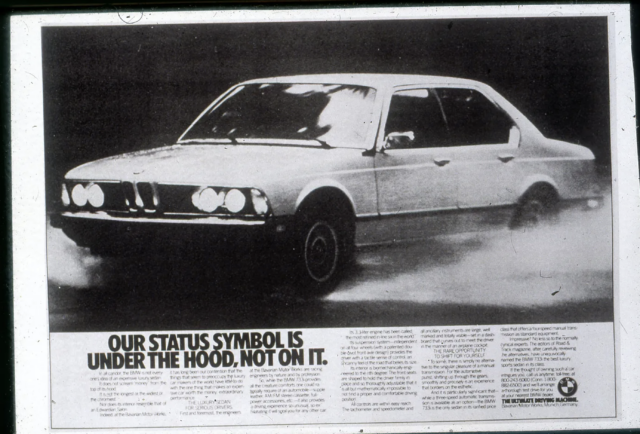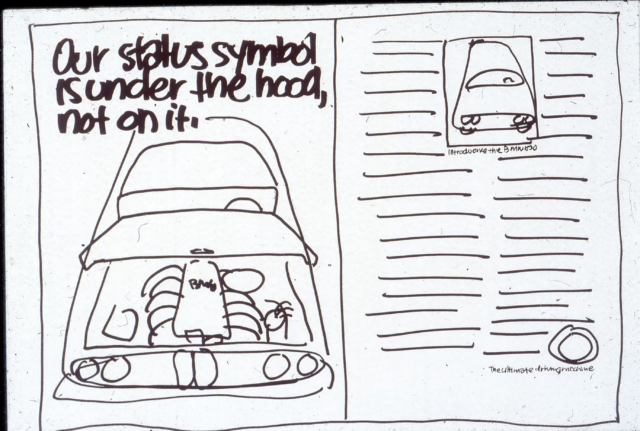Does anyone remember a time before BMW? Unlikely. The German import has been on American streets since before most people were born. But in 1973, two advertising guys named Martin Puris and Ralph Ammirati ditched Carl Ally Advertising and...
Does anyone remember a time before BMW? Unlikely. The German import has been on American streets since before most people were born. But in 1973, two advertising guys named Martin Puris and Ralph Ammirati ditched Carl Ally Advertising and the Fiat account to rent a hotel room in midtown Manhattan. They gave themselves four weeks to get a paying advertising client. After three weeks, they had no one. On week four, they got UPS. The very next year, BMW followed.
At the time, BMW (Bayerische Motoren Werke) was an upstart German automobile manufacturer trying to follow Volkswagen’s enviable lead in the U.S. market. The new account required a new art director, so they hired Clem McCarthy, a San Francisco native. Clem and Marty Puris had worked together in Detroit. Clem grew up in San Francisco and went to Mill Valley High School. On weekends, he drove along the curving roads of nearby Mt. Tamalpais. So, when it came time to shoot BMW’s first television commercial, Clem knew exactly where to go.
Like perfume ads, car commercials like to show a lot of skin. The camera lens lovingly drapes itself along the shapely automobile silhouette. Slow-motion “beauty shots” typically demonstrate steering and suspension systems as they absorb road curves and the passionate thrill of driving.
Not BMW. The first BMW 30-second television commercial featured the front end of a BMW coming toward us. Then the oncoming car descended into a hillside. And disappeared. Viewers waited for the vehicle to reappear. It did, but then the unidentified BMW disappeared behind the next hill. The road was like a roller coaster. The full-length BMW did not reveal its sporty self until the final scene.
“They leveled and straightened the road the week after we shot,” grinned McCarthy. No reshoots. The Mt. Tamalpais landscape was so unexpectedly stunning that auto manufacturers shot on Mt. Tamalpais roadways as a matter of course for the next 30 years. Although television production was sexy, it was also expensive. And it costs millions of dollars to put on the air. So, many foreign car manufacturers (Volkswagen, Volvo, Subaru, Honda, and more) relied on less expensive print advertising to carry the weight of their messaging.

How the first BMW print ad actually ran in publications. Note the long copy, which was active reading and made Ammirati & Puris copywriters like Marty Puris and Joe O’Neill famous
The first print advertisement for BMW (above) started as a pencil sketch. On his last day in the business, Clem McCarthy pulled the original sketch (below) from the flat file in his office and handed it to me.
Like the television commercial, the front grille of the 300 Series luxury car is headed toward the viewer. The redundant BMW engine reveal is gone. Notice also that the finished version has the sexy wide shot of the car in motion. And the headline is accompanied by the sophisticated long copy that described at length what made BMW “the ultimate driving machine.” The BMW campaign proved year after year that long copy works when written well.
What the photo doesn’t show is that the original pencil sketch has some erasing marks around the theme line — as if another set of words had been tried and failed.

“The ultimate driving machine was always the best line,” recalls agency co-founder Marty Puris, who wrote the famous BMW tagline. Also, in an update, Marty revealed that the print ad above was not the first ad. The first BMW print ad was simply a photo of the BMW with the declaration, “The ultimate driving machine,” which launched the new position.
(NOTE: Clem’s long career bumped between Marty Puris in New York City and Hal Riney in San Francisco, where Clem McCarthy enjoyed an equally historic career. Clem remembers sitting on the floor between Hal Riney and Earnest Gallo one afternoon, thumbing through telephone books trying to find the names “Bartles & Jaymes” in anticipation of another legendary advertising campaign.) Good work, Clem.
According to The One Club Hall Of Fame, “The Ultimate Driving Machine” positioning line still defines the BMW luxury car today, forty years later. Arriving just as baby-boomers were launching their professional careers, BMW became a symbol of independence, success, and authentic performance.
And it still is.
Contributed to Branding Strategy Insider by Patrick Hanlon, Author of Primal Branding
The Blake Project Can Help You Craft A Brand Advantage In The Strategic Brand Storytelling Workshop
Branding Strategy Insider is a service of The Blake Project: A strategic brand consultancy specializing in Brand Research, Brand Strategy, Brand Growth and Brand Education
FREE Publications And Resources For Marketers











